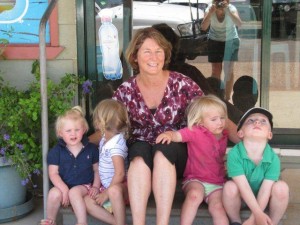
Intrepid US soul lends a hand in the Outback
Californian speech pathologist Stephanie Perrett discovered the raw charm of the Outback, including a hungry pack of kite hawks, while lending a hand as a volunteer with Frontier Services program Outback Links.
It was a lifelong dream to take our kids to another country to experience life somewhere else, and we had always loved Australia. With my husband Tom, son Eli, 15, and daughter Melissa, 13, we packed up our Californian life and moved to Coolum Beach on the Sunshine Coast in Queensland.
The kids were enrolled in the local high school. Tom and I enjoyed our year off making new friends, and we spent much more time together than we had been in California. It was great.
Our iconic Aussie experiences included seeing the ‘big’ things dotted along the highway, meat pies for sale on every corner, driving through liquor stores and not being able to just order a cup of coffee (it had to be some version of espresso).
I wanted to do something meaningful while I was in Australia. So, I spent 10 days as a volunteer with Outback Links, an organisation that matches intrepid souls in placements that help remote families deal with the realities of living in the back of beyond.
I flew from Brisbane to Charleville, a two hour flight (or a 14 hour drive).
After spending a night with an Outback family who received in-home childcare assistance from Frontier Services, I teamed up with the Remote Area Families Service (RAFS) team. These are dedicated educators, undeterred by the isolation and extensive travel requirements of their job, who provide play-based enrichment for children up to age five.
I accompanied RAFS field coordinator Emma for six playgroups in six days. We loaded the 4WD vehicle up to the roof racks with dress up clothes, paint and glitter, soap bubbles, a train set, a water slide and a wading pool. At each stop, we set up the playgroup at the town park or hall on the grass. The mums and tots poured in from the surrounding properties, some coming from up to two hours away.
I read to the kids, played Legos with them, made bubbles, sprayed water on the slippery slide, and helped out however I could. Several mums had questions about speech development and I was able to provide information about developmental milestones and offer suggestions for encouraging language learning.
Travelling between two and six hours, we’d arrive in the next town, spend the night, and get up the next day to do it all again. ‘Town’ is relative term, two of the ‘towns’ we came through had a population of less than five people.
One such place we stayed was Noccundra, where our accommodation was decidedly one star. Emma and I each had our own room, which thankfully boasted an air-conditioning unit, a tiny mirror, a disassembled smoke alarm, two twin beds with 30cm between them and a bible. The amenities across the cement step featured cute little frogs emerging from the sink and gripping the shower curtain.
In between our stops was nothing. Well, not nothing – rocks, red dirt, trees, occasional small hills, more red dirt, cattle, sheep, goats, emus, snakes and kangaroos. The further west we drove, the more barren the landscape. Bird life was abundant; we saw apostle birds, budgies, butcher birds and one pair of brolgas. On the last day we saw wedge tailed eagles, one of the largest birds of prey, they can carry off lambs! Happily the three venomous snakes I saw were dead.
We sometimes encountered a vehicle or two and sometimes not. Once, for about a kilometre, there was a dotted white line down the middle of the road: it was there in case the road needed to be used as an emergency landing strip.
The isolation didn’t bother me, but then I wasn’t by myself. I would not have felt comfortable driving those distances alone, as I am not a mechanic. However, if we passed anyone stopped on the side of the road, as a courtesy people always made sure they were OK.
In Eromanga, population 40 and the point in Australia that is furthest from the sea, I had an unusual experience. On my usual evening walk, I was admiring the wing span of the kite hawks circling above. Soon there were about seven or eight of them. They seemed to be following me and came a little lower if I stopped walking. I realised the birds were keyed into my status as a slow moving solitary mammal. They were hoping for me to die, so they could have their next meal!
We ended up back in Charleville and I spent the night there before flying back to Brisbane. I travelled more 3000kms in 10 days.
I would unequivocally recommend volunteering with Outback Links to other travellers. It was a fabulous way to get to know a part of Australia that most Australians don’t get to see.
By Stephanie Perrett
